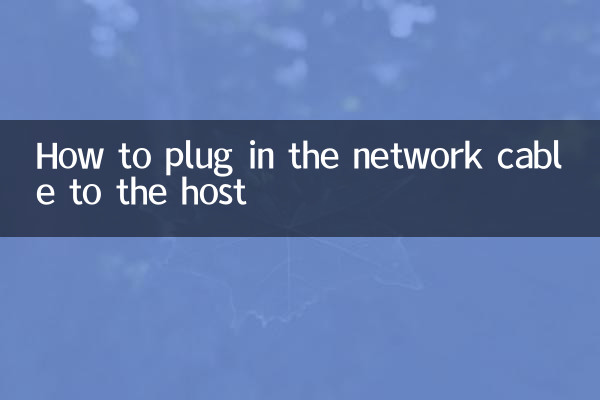How to plug in the network cable to the host: a comprehensive guide from beginner to proficient
In the digital age, network connectivity has become an integral part of daily life and work. Whether you are a home user or an enterprise user, correctly connecting the host and network cable is the first step to ensure a smooth network. This article will introduce you in detail how to plug in the network cable to the host, and attach the hot topics and hot content in the past 10 days to help you better understand all aspects of network connection.
1. Basic steps for plugging in the network cable to the host

1.Preparation: Make sure you have a good network cable (usually an RJ45 interface) and a host that supports wired network connection.
2.Find the network port: The network port of the host is usually located on the back of the chassis and is labeled "LAN" or "Ethernet".
3.Plug in the network cable: Align the crystal head of the network cable with the network port, insert it gently, and hear a "click" to indicate that the connection is secure.
4.Check connection: Observe the indicator light next to the network port. Usually the green light indicates that the connection is normal, and the yellow or flashing light indicates that data is being transmitted.
2. Common problems and solutions
1.Network cable cannot be plugged in: Check whether the network cable and crystal head are damaged, or try to replace the network port.
2.No network after connecting: Confirm that the router or modem is working properly, or check the host's network settings.
3.Internet speed is too slow: It may be that the quality of the network cable is poor or the network is congested. It is recommended to replace the network cable with a higher specification (such as Cat6).
3. Hot topics and content in the past 10 days
| date | hot topics | Hot content |
|---|---|---|
| 2023-10-01 | Popularization of Wi-Fi 6 technology | Many manufacturers have released routers that support Wi-Fi 6, with significant speed improvements. |
| 2023-10-03 | Cyber security incident | A large company suffered a hacker attack, triggering widespread discussions on network security. |
| 2023-10-05 | 5G network coverage expansion | Many cities in China have announced the completion of full 5G network coverage, with download speeds exceeding 1Gbps. |
| 2023-10-07 | The rise of cloud gaming | A number of cloud gaming platforms have been launched, allowing users to play AAA masterpieces without the need for a high-performance host. |
| 2023-10-09 | Smart home interconnection | A new protocol, Matter, was released to promote the interconnection of smart home devices. |
4. Network cable types and selection suggestions
| Network cable type | maximum bandwidth | Applicable scenarios |
|---|---|---|
| Cat5 | 100Mbps | Ordinary family Internet access |
| Cat5e | 1Gbps | small business or hd video |
| Cat6 | 10Gbps | Large enterprise or data center |
| Cat7 | 40Gbps | High-end applications or future needs |
5. Summary
Properly plugging network cables is the foundation of network connection. Choosing the appropriate network cable type and paying attention to the latest network technology trends can help you obtain a more stable and faster network experience. I hope that through the detailed introduction and structured data of this article, you can easily master the skills of plugging the network cable into the host and be able to use it with ease in practical applications.
If you have other questions about network connection, please feel free to consult relevant technical documents or consult professionals. The online world is infinitely vast, and I wish you a worry-free journey!

check the details

check the details